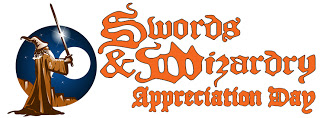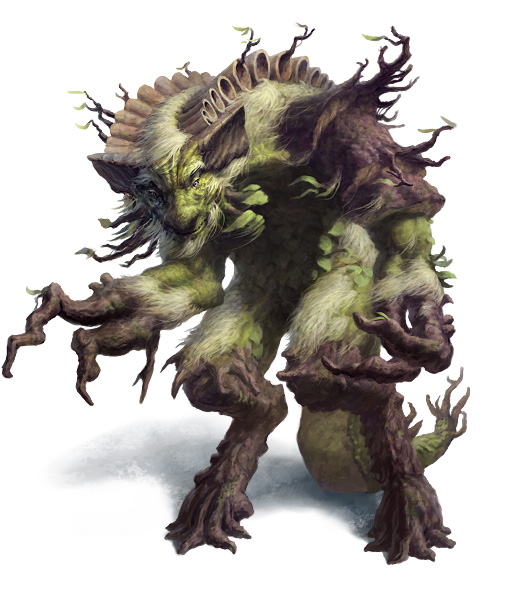
It’s Swords & Wizardry Appreciation Day! So, here goes: I appreciate Swords & Wizardry. Seriously. In a moment, I’m going to tell you why, but before I do, let me try to make something clear. I’m going to say things about Swords & Wizardry, Matt Finch, and Mythmere Games, and Frog God Games. These things might be true about other games, people, and companies. In fact, these things are true about other games, people, and companies. If I say I appreciate Thing X about Swords & Wizardry, I’m not saying that no other game includes Thing X. In other words, I’m not dissing the games, people, and companies you appreciate.
You might be thinking, “Why the explanation, Mark?”

Well, in doing what passed as research for this blogpost, I came across a whole bunch of snippy bloviation about all things Old School Renaissance, including Swords & Wizardry and Matt Finch, specifically Matt’s “A Quick Primer for Old School Gaming” (for example). High-horse riding seems endemic in many discussions of Old School gaming, and I now avoid them. I’ve got better things to do with my time than listen to some “expert” tell me I’m playing badwrongfun, or that I’m not really Old School, or that what I’m talking about isn’t even a real role-playing game.
But enough snippy bloviation! Let’s do some appreciation!
Why I Appreciate Swords & Wizardry
Let me count the ways!
1. It’s free. There’s even an RTF version available for house-ruling.
2. It has an SRD, which means I don’t even need the book to play.
3. I don’t need the book to play, even if there wasn’t an SRD. Seriously. Not too long ago I GMed a Swords & Wizardry/Stars Without Number mash-up. I didn’t have to refer to the rulebooks once throughout the four-or-so hours of game time. I didn’t even have the rulebooks with me. Everything I needed for the game that night fit on about a dozen or so sheets of paper, mostly character sheets for the players. I’ve been playing (and writing) for Pathfinder almost exclusively for about five years. Pathfinder is a great game that I cannot run for four hours without referring to the rules.
Why I Appreciate Matt Finch
With more counting, or course:
1. Matt’s a fellow Texan.
2. Matt has demonstrated himself to be an approachable game designer who’s willing to take a personal hand in representing his product in a positive manner for consumers.
3. Did I mention that Swords & Wizardry is free?
4. Matt wrote this:
“Most of the time in old-style gaming, you don’t use a rule; you make a ruling. It’s easy to understand that sentence, but it takes a flash of insight to really ‘get it.’ The players can describe any action, without needing to look at a character sheet to see if they ‘can’ do it. The referee, in turn, uses common sense to decide what happens or rolls a die if he thinks there’s some random element involved, and then the game moves on. This is why characters have so few numbers on the character sheet, and why they have so few specified abilities.”
For me, this almost perfectly sums up one of the big attractions of “old-style gaming”. Why only almost perfect? Well, I demur a bit from the third sentence. I think it’s quite acceptable for players to have a bigger share in the common sense decisions and dice rolling than stated above. (And, yes, this thinking is one of my thoughts that has been sometimes vociferously condemned as not truly Old School or, terror of terrors!, not even actual role-playing.)
Why I Appreciate Mythmere Games and Frog God Games
1. Did I mention that Swords & Wizardry is free?
2. Both companies exemplify the sort of friendly professionalism that I cannot help but admire. Search around the Interwebz to see that Frog God Games has put right the Razor Coast debacle. I’ve seen numerous examples of company reps responding quickly to problems voiced on social media sites, such as Google+.
3. If the free version of Swords & Wizardry isn’t your cup of tea, you can purchase the rules in lovely book form. Most reviews I’ve seen praise the quality of the books being published by Frog God Games. Check out this review, for example.
4. There’s an impressive amount of product support out there for Swords & Wizardry, and a whole bunch of it, including the core rules themselves, has been released via the Open Gaming License.
Whew! That’s 11 different items I appreciate about Swords & Wizardry. Well, sort of. I mentioned the free thing more than once. If you’ve not experienced the Old School, give it a try. You might like it. You might even like it better than what you’re playing now.
Tags: A to Z 2013, Swords & Wizardry, Swords & Wizardry Appreciation Day


 Attacks: 2 claws (1d4), or fin slash (1d6 + infection)
Attacks: 2 claws (1d4), or fin slash (1d6 + infection) Matt Jackson over at Lapsus Calumni is running a
Matt Jackson over at Lapsus Calumni is running a 